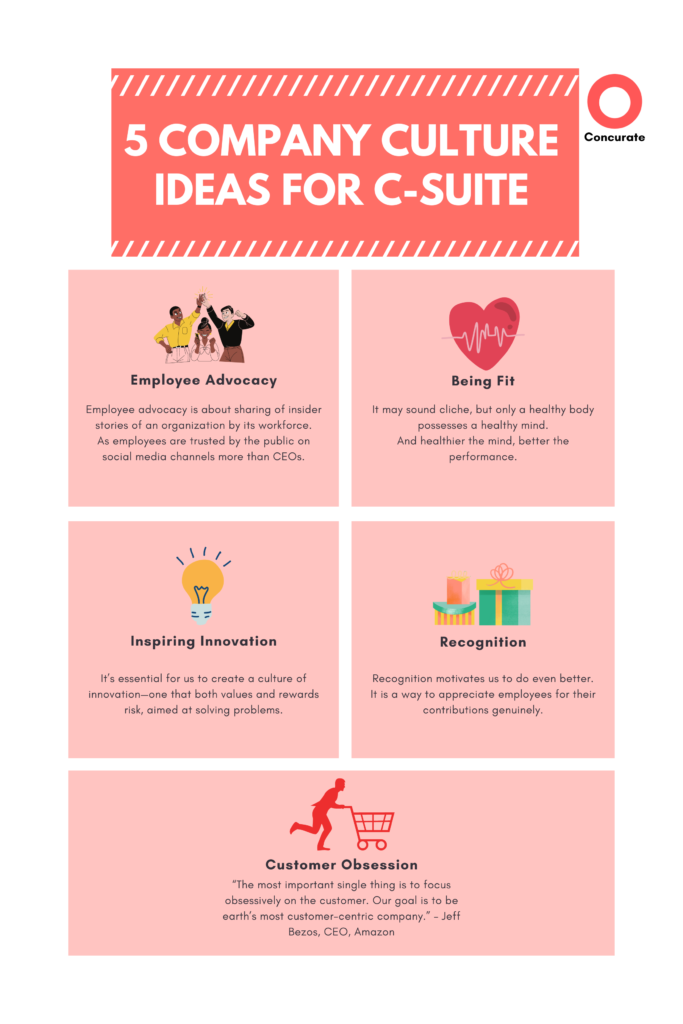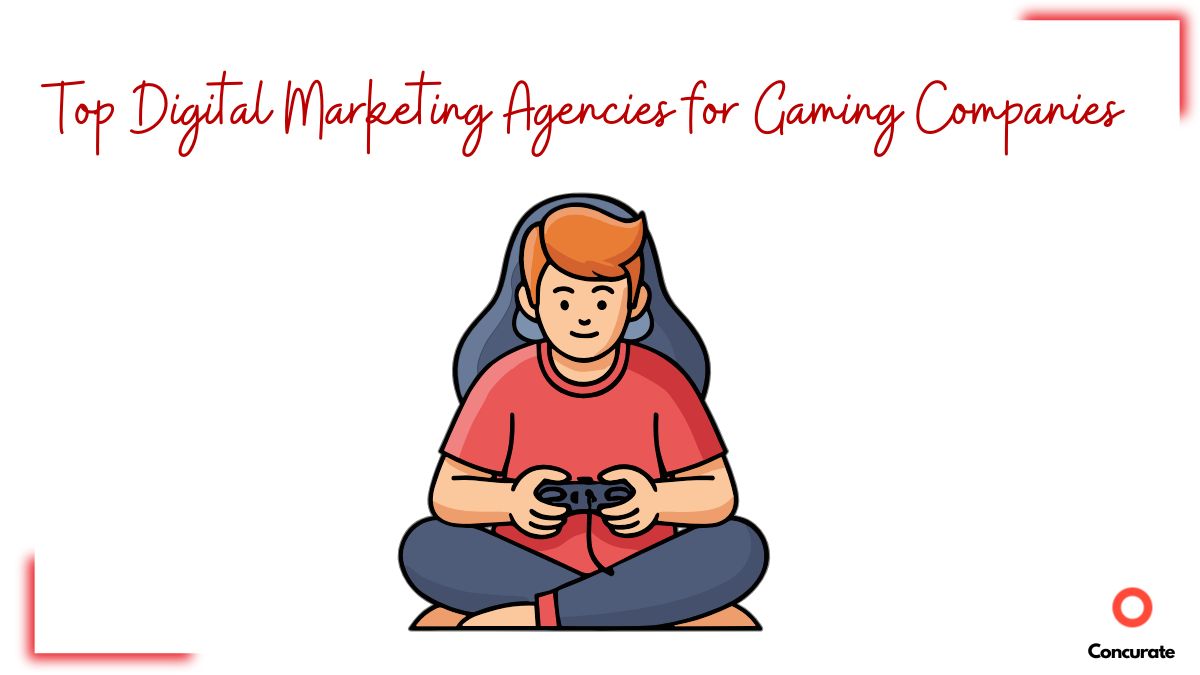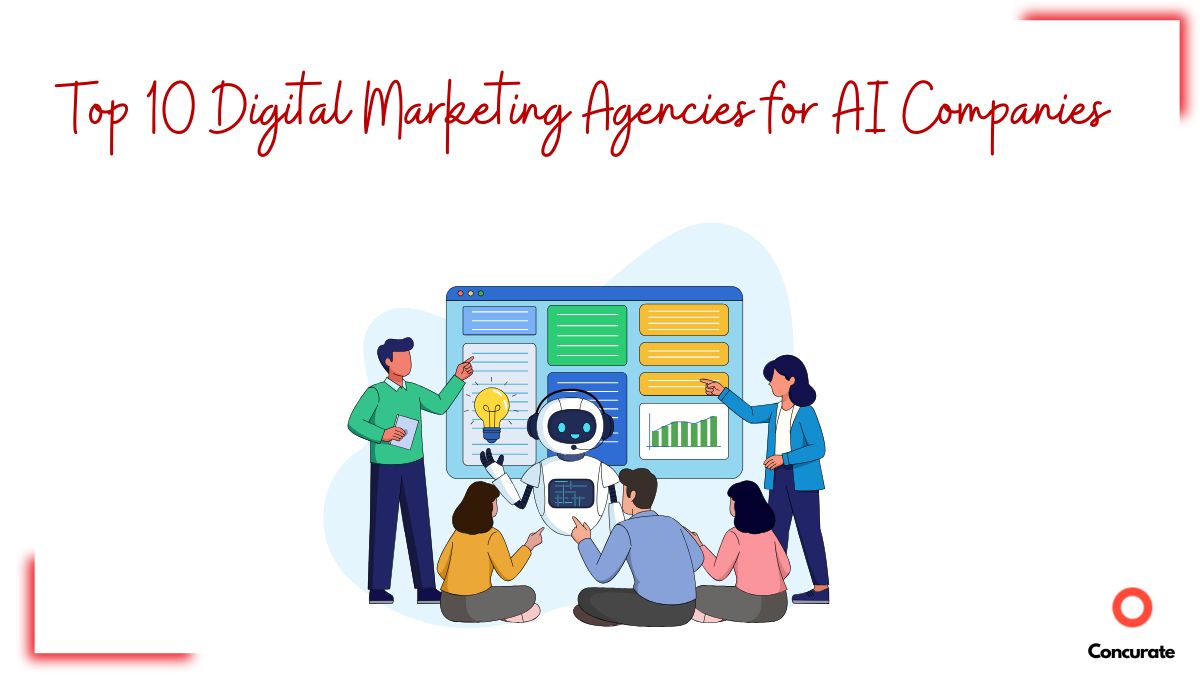
What Successful CEOs don’t tell you about the Culture?
Company culture is not just a status symbol!
Company culture is not about adding “#cool” factor to your organization!
It’s a dedicated effort to achieve something phenomenal!
It is just a part of a big plot with a capitalistic mindset.
Ultimately, any cultural practice in a company should contribute towards the greater revenues for the company!
As a CEO, it’s your choice to pick the best ones for your company!
What’s there in this article for you?
In this article, I have picked up the top 8 culture ideas from the most successful companies across the globe.
Most of the ideas are supported by Concurate’s insight on “Why CEOs have brought such a practice in the company?”.
That’s, the real purpose!
Also, each idea is supported by actionable steps to achieve a particular cultural practice.
By the end of the article, you would be able to choose the best ideas for your company.
These are the 8 ideas explained in detail below:
- Employee Advocacy.
- Being Fit.
- Inspiring Innovation
- Being Thankful.
- Recognition.
- Customer Obsession.
- Being Empathetic.
- Strictly No Jargon
Employee Advocacy.
Employee advocacy is the promotion of an organization by its workforce.
Why by employees?
Because employees are trusted by the public on social media channels more than CEOs.

Simply put:
- Employees share information about specific products or campaigns.
- Employees share the internal chatter of the company projecting their work approach.
- Employees share about a company’s gestures which made them feel special.
- Employees share their achievements i.e. When the company recognizes employee’s talent.
- Employees share company’s achievement on a certain project if they were part of the team.
Employees share such information on different social media platforms.
That becomes visible to their network.
Let’s say, there are 100 employees in an organization.
And the organization’s current reach is 10000 people.
Each employee has on an average:
- 100 connections on Facebook.
- 150 connections on Linkedin.
- 30 followers on Twitter.
If a message is shared by each of the 100 employees on each of these platforms.
The message becomes visible to 100 X (100 + 150 +30) = 100 x 280 = 28000 people.
Thus, increasing the organization’s reach by 180%.
Besides, increased outreach, employee advocacy has a few more benefits:
- Attracting like-minded talent and right set of clients.
- Brand reputation gets a boost when brand stories come straight from employees.
- Employee Attrition decreases.
But, two very important questions here:
What’s do employees gain by sharing the content for their employer?
What shall drive them to willingly share corporate content?
The answer is 2Cs.
Career & Culture.
Career
If content sharing can help employees achieve professional visibility within and outside of the organization.
Culture
If the employee feels ownership of your organization’s narrative.
i.e.
If an employee feels he is contributing to something bigger than just a 9 to 5 job.

Concurate’s Perspective
There are tools available in the market which help in driving employee advocacy programs in a company.
These tools provide employees with pre-approved content to be shared on their social media profiles.
However, at Concurate, we feel that such posts should come straight from employees’ hearts and natural willingness.
Then only, employees become advocates and not ambassadors.
The idea is to bring the company’s internal chatter out to showcase its culture, work approach, competence etc.
Being Fit.
It may sound cliche, but only a healthy body possesses a healthy mind.
And healthier the mind, better the performance.
This culture idea is inspired from the greatest company I have ever known, its called Singapore.
There is a lot, that companies can learn from the story of Singapore.
I have it saved for another post. Stay tuned!
Here is how a culture of fitness benefits the company!
- Fitness lowers insurance costs.
- Healthy individuals have a lower probability of being absent at work.
- Fit individuals get less stressed, thus contributing positively to the organization.
- Fitness fosters team spirit when employees get to work out with each other.
Below are some action steps to bring in the culture of fitness in your company:
- Leaders go first. People get inspired by actions more than words.
- Conducting fitness challenges in the company, where leaders are the first ones to participate. Examples:
- 1-minute plank challenge.
- The 50-squats challenge.
- 200-skips with a skip rope challenge.
- Dance contests. Flash mobs.
- High-Stretch Yoga Challenge.
- Making healthy food available in the company cafeteria.
- Conducting talks by experts on fitness.
- Focusing on ergonomics, for correct sitting postures.
- Keeping fitness as one of the hiring criteria.
Concurate’sPerspective
No cultural practice is imbibed anywhere without any substantial gain.
Why do you think it is a mandate by the government for its men to go for National Service?
Singapore is a small country, but it stays ready to face anything that future may bring.
Even war. (May such a thing never happen!)
Singapore makes sure that each of its men is trained to be a soldier.
This actually has multi-fold benefits:
- Men from each family have to compulsorily go for National Service.
- They get trained to be a soldier, whenever the country might need them.
- Because of the rigorous training, they become very strong physically.
- Fitness becomes a pleasure and exercise becomes a habit for him.
- Not just exercise,
- His family gets inspired by him to be fit
- A healthy family lowers its medical expenses.
- The government saves tax money, which would have otherwise been spent on medical care.
- It’s a win-win for the whole nation.

Inspiring Innovation
“It’s important for us to create a culture of innovation—one that both values and rewards risk.” Barbara Landess CFO, PBS
Innovation doesn’t necessarily be about a breakthrough tech product.
Innovation can be aimed at solving a problem.
Example: Ear band for a face mask, so that ears do not get strained.
Innovation can be aimed at enhancing the user experience.
Example: Floating Breakfast in the swimming pool.
Innovation can be aimed at speeding up a business process.
Example: David Skok squeezed his sales cycle of a few months into just 1 day.
And in that one day, he made $4million in sales.
Do you want to know how? Hear this short podcast about his story.
Here are 3 ways to achieve the culture of innovation:
- Engrave the following message on the minds of everybody in the company:
- Be obsessed with solutions than problems.
- The moment, any problem arises, and you don’t know the solution to it.
- Experiment with any solution that comes to your mind.
- It’s absolutely okay to fail. If one solution doesn’t work, try another.
- But please never stop experimenting.
- Because the experiment is the first step in innovation.
- The probability of success and failure is 50-50 for every experiment.
- Encourage failure. (Dyson’s bagless vacuum cleaner was perfected only after a staggering 5,127 tries.)
- Reward success. (Starbucks rolls out drinks )
- Idea management platforms. A platform where:
- Employees can collaborate and brainstorm ideas.
- Targeted Innovation challenges/Hack-a-thons can be conducted.
- Product development can be driven by customer insights and employee’s ideas.
For a lighter take on leadership and innovation, our list of inspiring leadership lessons from movies
shows how creative thinking shapes teams and brands.
Concurate’s Perspective
The results of such innovations bring breakthrough results in favor of the company!
Ultimately, contributing to more revenue for the company!

Being Thankful.
“Finding gratitude and appreciation is key to resilience. People who take the time to list things they are grateful for are happier and healthier.” Sheryl Sandberg COO, Facebook
Why do colleagues need to express gratitude towards each other?
Do you feel good, when somebody thanks you for your help?
I am sure you do.
Do you feel good, when somebody appreciates your work?
I bet, you do!
What happens when you feel good?
Even the challenges look fun and easy.
Showing appreciation to your coworkers is mutually beneficial.
It builds Camaraderie. Generates good will. Boosts a sense of self-worth.
All these perks can make workdays a little easier for everybody.
Why do you need to send “Thank-You” email to clients after calls?
Is it merely a gesture of respect?
No, there is much more to it.
Your prospect probably had 10 similar calls the following week.
Chances are bleak that he will remember you.
Unless you made sure he will…
How will he remember you out of those 10?
One way is to drop a personalized “Thank-You” email.
Also making sure that in the mail, You:
- Revisit the client’s pain-point.
- And, how can you help him to solve the pain-point.
Below are some steps to achieve the culture of gratitude:
- Choose a day in a week, let’s say Thursday.
- Call it “Thank You Thursday”.
- On this day people are asked to write “Thank You” messages for anybody who helped them in the whole organization.
- This feature can be incorporated in the software where employees communicate with each other.
- Making it a mandate to send “Thank You” emails to clients after every call.
- Just imbibe the habit of expressing thanks for all big/small things across the organization.
Recognition.
Recognition motivates us to do even better.
This holds true for any age group.
As a child, I remember my arts teacher appreciating my work.
He used to help me prepare for inter-school painting competitions.
And, I always bagged a prize in these competitions.
This recognition via words and trophies always motivated to do even better in arts.
As a wife, when I cook a meal and my family enjoys it heartily.
I feel so happy and try to make new tasty food for them.
As a copywriter when I see a super-low bounce rate.
That, the people are reading what I write and hopefully benefiting from it.
I feel motivated to bring even more valuable content to my readers.
In exactly the same way recognition of employees at the work-place makes them feel valued.
It motivates them to perform even better.
As Simon Sinek says:
Don’t criticize when people do something wrong.
Do recognize when people do something right.
Amplify the positive emotion.
Recognition is a way to genuinely appreciate employees for their contributions.
Contributions not just to succeed in business, but being influential in their teams.
Another little piece of wisdom to add here is:
A “Good job” compliment from Boss.
Vs.
“I aspire to be like you from a colleague or a junior”.
Has a much deeper motivational effect on the employee.
Following are 3 ways to recognize employees:
1. Employee Recognition day: Just as we celebrated Rose Day in college. On “Employee Recognition Day” employees give certain token (maybe a smiley ball) to the person who’s inspired him/her the most at the workplace.

2. Employees giving goodie points to anybody in the organization driven by any interaction they might have had with each other. It could be peers, juniors, seniors, employees from different departments…… Just anyone who is a part of the organization. There are tools dedicated towards employee recognition example Empuls, Compass, Plum by Xoxoday.
3. Conducting challenges/hack-a-thons/make-a-thons/competitions/events where employees get to showcase their talents beyond the routine work. And rewarding the winners with interesting prizes.
Concurate’s Perspective
Recognition motivates employees to perform even better.
The improved performance brings more wins for the company.
Besides, Conducting events and challenges outside of the regular work give employees an opportunity to improve their:
- People Skills.
- Leadership Skills.
- Management Skills.
As these are outside of work, these act as a low-risk ground to test and improve.
Customer Obsession.
“The most important single thing is to focus obsessively on the customer. Our goal is to be earth’s most customer-centric company.” – Jeff Bezos, CEO, Amazon
As a customer, what do you expect from a service provider?
- Hassle-free Service.
- Delivered as Promised.
- Timely Completion.
- Worth the Money you spent.
- A Delightful Experience.
Let’s just pick one service from Amazon’s portfolio.
Say, Amazon Prime, in Singapore.
I order groceries from them every 3rd day.
I would not even go to any other store, if they had Indian groceries too in particular.
As a customer, Amazon Prime is my first choice for ordering groceries online.
Wondering WHY?
For plenty of reasons:
- Fast Delivery.
- Packaging (Insulated packing with cold gel packs for milk and frozen items is definitely worth the appreciation).
- Mobile App User Experience is Splendid for the following reasons:
- Super Clean Interface.
- “Shop Past Purchases” feature makes it faster and convenient to order.
- Indication of delivery schedule even before I begin to add stuff to my shopping cart.
- Received goods are exactly as same as shown in the picture in the app.
- It rarely happens that stuff delivered is expired or rotten or not as expected.
- Though very rarely needed, returns are accepted without any questions asked.
- It gives a free delivery at a minimum order of 40 SGD, which is an easy target to reach for a family with 3 adults and 2 kids. A family that eats three different home-cooked meals a day.
How has Amazon achieved this?
By creating a culture of customer obsession across the company.
i.e.
By aligning each and every action in the company towards delighting the customers.

Concurate’s Perspective
Amazon gets the customers hooked so badly into this habit of convenience that no amount of surge afterward will act as a show-stopper.
Being Empathetic.
Empathy is being concerned about the human being, not just their output. – Simon Sinek, Well known for his gift called “The Golden Circle” to the world.

Once I heard Simon Sinek telling a story that drew contrasts between two types of managers.
One who leads the team with empathy.
The other, who’s just focused on the end result.
Here is the story:
A few months ago, I stayed at the Four Seasons hotel.
It’s a wonderful hotel, not because of its aesthetics and amenities.
It’s wonderful because of the people who work there.
If you walk past somebody at Four Seasons, they greet you with “Hello”.
And this “Hello” doesn’t feel imposed on them.
It seems to come from within.
It actually feels that they care for you.
One afternoon, I went to buy a cup of coffee at their coffee stand in the Lobby.
There was a barista by name Noah, who was serving me.
Noah was so much fun and friendly and engaging with me.
I remember paying a 100% tip.
Out of curiosity, I asked Noah: “Do you like your job?”.
Without skipping a beat Noah said, “I love my job”.
My curiosity grew.
I asked him, “What is ‘Four Seasons’ doing that makes you love your job?”.
Again, without skipping a beat, Noah answered.
“Throughout the day the managers will walk past me and ask me how am I doing,
if there is anything I need to make me do my job better.
In fact, not just my manager, any manager.”
And then Noah said something magical.
“I also work at Ceasars Palace.
At Ceasars Palace, managers are trying to make sure that we do everything correct.
And they would catch us whenever we do anything wrong.
When I work at Ceasar, I keep my head under the radar and get through the day.
So that I can get my paycheck.
However, at Four Seasons I feel I can be myself.
Same person, but entirely different.”
The idea to be taken away from here is to make leadership empathetic towards their people.
Concurate’s Perspective
Inspire your company’s leadership to nurture its people and bring the best out of them.
Happy employees stay with the company, make talent acquisition easier, and help attract the right clients.

Strictly No Jargon
The other day we were on a call with a prospect.
This prospect of ours needed help with the marketing funnel.
While in conversation, he pointed this to us.
“I have spoken to other companies also, but they mostly talked jargon to me.
And they looked really shallow below the jargon.
However, I feel that you guys have excellent communication skills.
And I am able to understand everything you are speaking.”
It felt like a true compliment.
We believe that simple language and easy to understand words make communication stronger.
Whether the communication is taking place between the client and the company or within the company.
It’s meaningful only if the other person understands what’s being said.
Pro tip: If you need 30 standout SaaS growth hacks to attain double the growth for your SaaS business, fill out the form below!
Hope you enjoyed reading the article :).
If you wish to read more goodness, Subscribe to our newsletter.
We send value to your inbox only once in 15 days.
Meanwhile, Explore the plethora of resources to help you out your business! If your organisation wants its content marketing strategy designed by Concurate, let’s connect over a short call. Block our calendar today!








